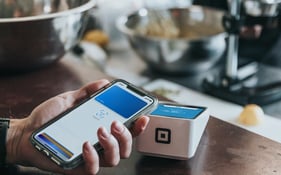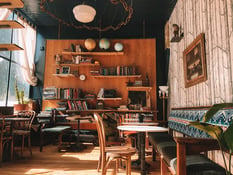Even the most experienced restaurant operators have had to tap some creative business approaches during the pandemic. In a time when health and safety drive many decisions, one service model — private dining — is enjoying a real moment.
Plenty of restaurants have long offered private dining for people who enjoy feeling special or who are seeking more intimacy. But as diners are allowed back into restaurants, the model takes on a new life, for diners who appreciate the sense of safety.
Your business may in fact depend on revenue from private dining, so set up your guests and staff for success — and maximize private dining sales. You may even find private or semi-private dining so effective that it becomes a bigger part of your business model once the world gets back to normal.
Why private dining works during a pandemic
For guests, private dining offers a ton of upsides. Dining in a more controlled environment with family or healthy “pod” members is a staple of pandemic-era dining. Let them know your safety protocols in advance, and assure them they'll have genuine separation from other diners. It's all to help put them at ease when public interactions may feel riskier than usual.
For people who've had to postpone or cancel gatherings, private dining offers a chance to celebrate or convene a small group. Consider this a great chance to provide hospitality to those who may be starved for the experience. Get as much advance detail as you can about the gathering (occasion, guest names, dietary restrictions, etc.) to make them feel even more welcome.
It's also helpful to consider that guests may see private dining as a way to support your restaurant. Carryout is fine. Gift cards and merch are handiest around the holidays. But your biggest fans would rather roll up to your restaurant and toast you in-person. “Don’t underestimate how your patrons value the opportunity to support their favorite local restaurant during these challenging times,” says Elizabeth Tulipana, a VP at Chicago’s 16 on Center group.
For restaurants, private or semi-private dining is a dream for planning. You can hammer out menus and a service plan in advance, making purchasing and staffing more predictable. Sales are already booked, so revenue depends less on walk-ins and weather. Requiring a deposit can help with cash flow.
Consider the layout of your space to assess how different configurations might allow for private or semi-private dining at the same time as walk-in or reserved parties. With luck, you can do both.
The guests who do have a great experience in their private dining make a perfect audience to pitch room rentals, on-premise or offsite catering, event planning, and more. Everyone has an event in their future — make sure they leave thinking about ways to throw another bash down the road.
How to promote private dining at your restaurant
For many operators, a focus on private dining departs from the usual, so your regulars and biggest fans may not be aware it’s an option. Let everyone know if you're offering special packages or discounts, via your digital channels and social media. Remember, some messages don’t sink in until people see them multiple times — don’t be afraid to sound redundant because not everyone sees every post or share. (Remember: Don't be afraid to sound redundant.) Make sure your website and Facebook page are up-to-date with offerings and promotions, and use regular email blasts if you have a list to share with.
Signs work as well. Banners and A-frames can help get attention on the street. Inside, take advantage of table tents or QR codes to alert guests to your private dining options.
You can canvas your neighborhood with flyers, free samples, or other tangible items to promote what you do. Consider demographics that may be “warm leads” for your business such as corporate admins/assistants, wedding planners, or community groups who meet regularly.
The goal here, as in all your restaurant marketing, is to show your best hospitality in everything you do. Your marketing always provides an opportunity to present the ways you take care of people. Every touchpoint is a chance to show off what you do. In short: Be as public as you can.
Challenges with private dining and COVID protocol
Communication, as they say, is key to getting everyone on the same page during a pandemic. Many guests will be vigilant about safety, while others will assume your standards match theirs, and still others might run afoul of your protocols. Be upfront. Let them know there's always going to be some risk, and show them how you're doing everything you can to minimize that risk.
As the restaurant operator, you’re responsible for what happens in your space. Some guests will ignore your protocols, especially once the wine starts to flow. Have a plan in place if guests put staff and other guests at risk. They may feel their “private” dining experience allows them to write their own rules. Don't be afraid to remind them this is not, in fact, the case.
How to accommodate private dining
Since every location is different, make sure diners know what to expect with your setup. Are you offering a reserved table, a private space (with closed doors and a separate room), or a semi-private space — apart from other tables, but where there may be noise and traffic from other guests nearby? Will you offer A/V equipment if there are presentations at a private event?
Guests may assume they know what their options are, so make sure to clearly state which accommodations you can make and what you’re unable to offer as well. Ideally you can put it in writing or present an image of the floor plan.
The logistics of private dining
It’s wise to walk your team through the steps of service. Private dining can be a significantly different style of service, with increased expectations. Your team should understand the logistical details, so make sure your staff is trained to knock it out of the park.
Also, be sure your team can also handle whatever the rest of the night throws at them, as well. "Preparing for a private event ahead of time by planning menus, knowing allergy/dietary restrictions, etc. sets the FOH and BOH staff up for success," Tulipana says. "It enables the team to juggle a flawless private dining experience as well as ensure you are able to give great service to your walk-ins, which by nature, can be unpredictable."
How to price private dining at your restaurant
Make sure to talk price upfront. Depending on the scope of the experience, you may offer a fixed menu with set pricing, additional charges for reserving private tables/spaces, or deposits.
On another financial note, make sure this is friendly to your profit margin first. Crunch the numbers on private dining overall. Make sure a big party is in fact big enough to offset any loss in walk-in guests.





